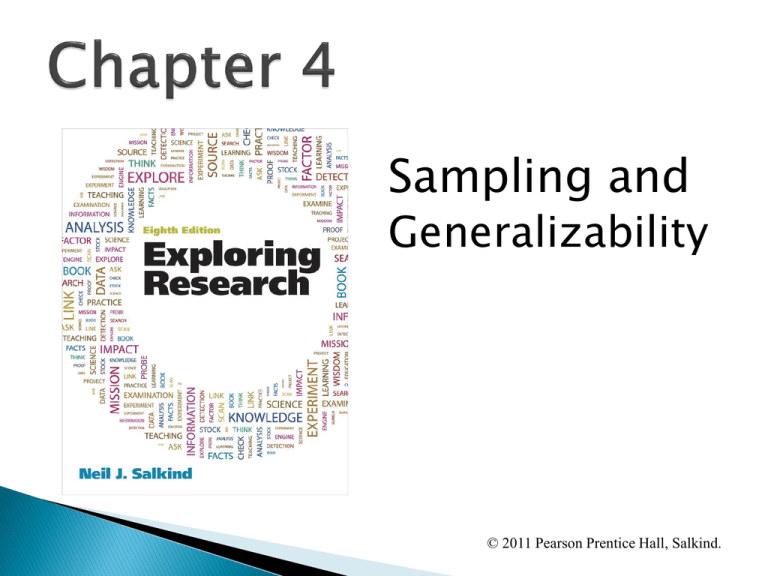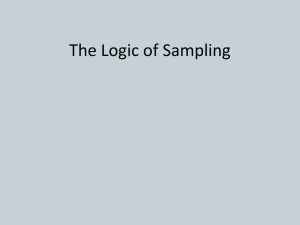
Sampling and
Generalizability
© 2011 Pearson Prentice Hall, Salkind.
Populations and Samples
Probability Sampling Strategies
Nonprobability Sampling Strategies
Sampling, Sample Size, and Sampling Error
© 2011 Pearson Prentice Hall, Salkind.
Inferential method is based on inferring from a
sample to a population
Sample—a representative subset of the
population
Population—the entire set of participants of
interest
Generalizability—the ability to infer population
characteristics based on the sample
© 2011 Pearson Prentice Hall, Salkind.
Probability sampling—the likelihood of any
member of the population being selected is
known
Nonprobability sampling—the likelihood of
any member of the population being selected
is unknown
© 2011 Pearson Prentice Hall, Salkind.
Simple random sampling
◦ Each member of the population has an equal and
independent chance of being chosen
◦ The sample should be very representative of the
population
© 2011 Pearson Prentice Hall, Salkind.
1. Jane
18. Steve
35. Fred
2. Bill
19. Sam
36. Mike
3. Harriet
20. Marvin
37. Doug
4. Leni
21. Ed. T.
38. Ed M.
5. Micah
22. Jerry
39. Tom
6. Sara
23. Chitra
40. Mike G.
7. Terri
24. Clenna
41. Nathan
8. Joan
25. Misty
42. Peggy
9. Jim
26. Cindy
43. Heather
10. Terrill
27. Sy
44. Debbie
11. Susie
28. Phyllis
45. Cheryl
12. Nona
29. Jerry
46. Wes
13. Doug
30. Harry
47. Genna
14. John S.
31. Dana
48. Ellie
15. Bruce A.
32. Bruce M.
49. Alex
16. Larry
33. Daphne
50. John D.
17. Bob
34. Phil
1.
2.
3.
4.
Define the
population
List all members of
the population
Assign numbers to
each member of the
population
Use criterion to
select a sample
© 2011 Pearson Prentice Hall, Salkind.
23157
48559
01837
25993
05545
50430
10537
43508
14871
03650
32404
36223
38976
49751
94051
75853
97312
17618
99755
30870
11742
69183
44339
47512
43361
82859
11016
45623
93806
04338
38268
04491
49540
31181
08429
84187
36768
76233
37948
21569
1.
2.
3.
4.
Select a starting
point
The first two digit
number is 68 (not
used)
The next number,
48, is used
Continue until
sample is complete
© 2011 Pearson Prentice Hall, Salkind.
Distribution of numbers in table is random
Members of population are listed randomly
Selection criterion should not be related to
factor of interest!!
© 2011 Pearson Prentice Hall, Salkind.
Those not selected
have a diagonal line
through the case (or
record) number.
There are ten
participants
selected in this
example.
The example uses
SPSS, but any
capable data
analysis tool can
produce a random
sample.
© 2011 Pearson Prentice Hall, Salkind.
1. Jane
18. Steve
35. Fred
2. Bill
19. Sam
36. Mike
3. Harriet
20. Marvin
37. Doug
4. Leni
21. Ed. T.
38. Ed M.
5. Micah
22. Jerry
39. Tom
6. Sara
23. Chitra
40. Mike G.
7. Terri
24. Clenna
41. Nathan
8. Joan
25. Misty
42. Peggy
9. Jim
26. Cindy
43. Heather
10. Terrill
27. Sy
44. Debbie
11. Susie
28. Phyllis
45. Cheryl
12. Nona
29. Jerry
46. Wes
13. Doug
30. Harry
47. Genna
14. John S.
31. Dana
48. Ellie
15. Bruce A.
32. Bruce M.
49. Alex
16. Larry
33. Daphne
50. John D.
17. Bob
34. Phil
1.
2.
3.
Divide the population
by the size of the
desired sample: e.g.,
50/10 = 5
Select a starting point at
random: e.g., 43 =
Heather
Select every 5th name
from the starting point
© 2011 Pearson Prentice Hall, Salkind.
The goal of sampling is to select a sample
that is representative of the population
But suppose—
◦ That people in the population differ systematically
along some characteristic?
◦ And this characteristic relates to the factors being
studied?
Then stratified sampling is one solution
© 2011 Pearson Prentice Hall, Salkind.
The characteristic(s) of interest are identified
(e.g., gender)
The individuals in the population are listed
separately according to their classification
(e.g., females and males)
The proportional representation of each class
is determined (e.g., 40% females & 60%
males)
A random sample is selected that reflects the
proportions in the population(e.g., 4 females
& 6 males)
© 2011 Pearson Prentice Hall, Salkind.
Grade
Location
1
3
5
Total
Rural
1,200
[120]
1,200
[120]
600
[60]
3,000
[300]
Urban
2,800
[280]
2,800
[280]
1,400
[140]
7,000
[700]
Total
4,000
[400]
4,000
[400]
2,000
[200]
10,000
[1000]
© 2011 Pearson Prentice Hall, Salkind.
Instead of randomly selecting individuals
◦ Units (groups) of individuals are identified
◦ A random sample of units is then selected
◦ All individuals in each unit are assigned to one of
the treatment conditions
Units must be homogeneous in order to avoid
bias
© 2011 Pearson Prentice Hall, Salkind.
Convenience sampling
◦ Captive or easily sampled population
◦ Not random
◦ Weak representativeness
Quota sampling
◦ Proportional stratified sampling is desired but not
possible
◦ Participants with the characteristic of interest are
non-randomly selected until a set quota is met
© 2011 Pearson Prentice Hall, Salkind.
© 2011 Pearson Prentice Hall, Salkind.
Sampling error = difference between
sample and population characteristics
Reducing sampling error is the goal of any
sampling technique
As sample size increases, sampling error
decreases
© 2011 Pearson Prentice Hall, Salkind.
The goal is to select a representative
sample—
◦ Larger samples are usually more representative
◦ But larger samples are also more expensive
◦ And larger samples ignore the power of scientific
inference
© 2011 Pearson Prentice Hall, Salkind.
Generally, larger samples are needed when
◦ Variability within each group is great
◦ Differences between groups are smaller
Because
◦ As a group becomes more diverse, more data points
are needed to represent the group
◦ As the difference between groups becomes smaller,
more participants are needed to reach “critical mass”
to detect the difference
© 2011 Pearson Prentice Hall, Salkind.
Apply the following concepts?
◦ Population
◦ Sample
◦ Random
◦ Generalization (generalizability)
Differentiate between probability and
nonprobability sampling techniques?
© 2011 Pearson Prentice Hall, Salkind.
Identify four (4) probability sampling strategies?
◦
◦
◦
◦
Simple Random Sampling
Systematic Sampling
Stratified Sampling
Cluster Sampling
Identify two (2) nonprobability sampling
strategies?
◦ Convenience Sampling
◦ Quota Sampling
© 2011 Pearson Prentice Hall, Salkind.
Explain
sampling error?
◦ List ways researchers can reduce
sampling error
◦ Summarize the effect of sample size on
sampling error
© 2011 Pearson Prentice Hall, Salkind.








